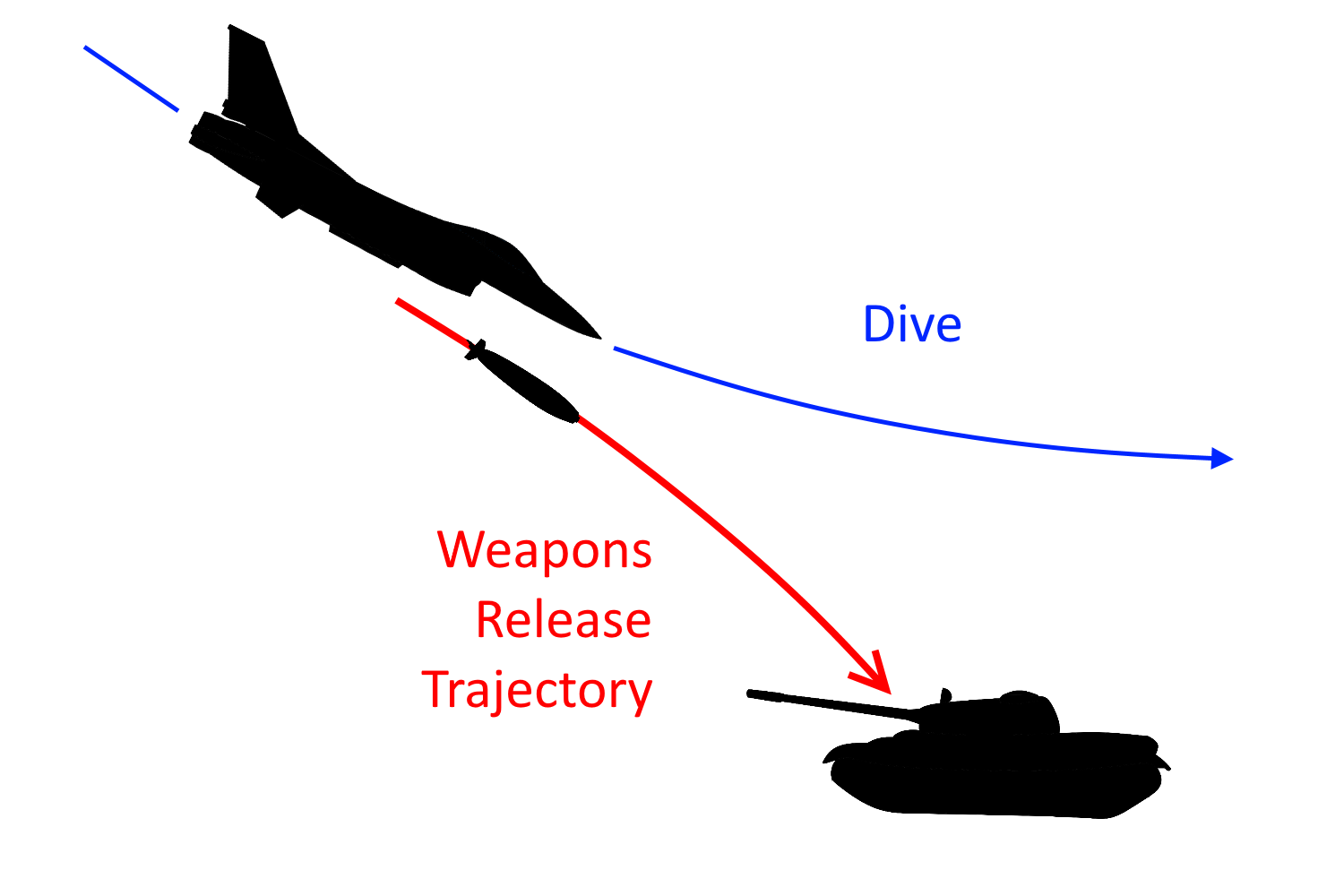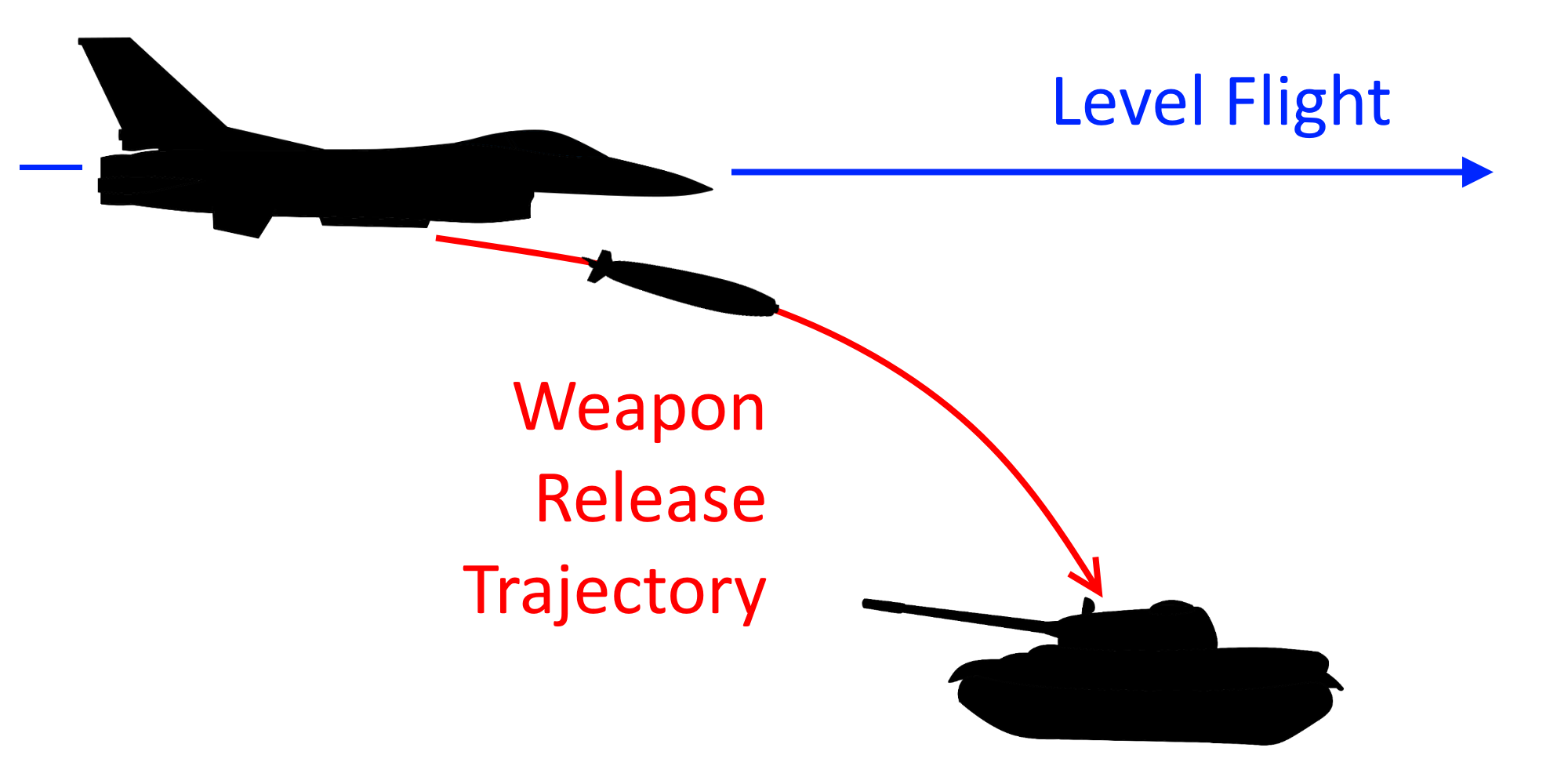Difference between revisions of "Air-to-Ground Combat"
(Created page with "<center>{{#widget:AdSense |name=Hoggitwiki header |client=ca-pub-6997190595986605 |slot=7221930773 |width = 728px |height = 90px }}</center> Air to Ground Combat is the vario...") |
(pictures, rewriting) |
||
| Line 17: | Line 17: | ||
=== CCIP === | === CCIP === | ||
| − | CCIP is perhaps the easiest of the release modes to grasp, as | + | <gallery widths=300px heights=300px> |
| + | File:CCIP.png|none|alt=Alt text|CCIP Release | ||
| + | </gallery> | ||
| + | |||
| + | CCIP is perhaps the easiest of the release modes to grasp, as you literally point your nose at the target and release the weapons in an attempt to hit the target. Weapons typically released via CCIP are rockets and unguided bombs, as well as bombs that are fitted with a retardation device (to slow them down in relation to the aircraft, for low level bombing). | ||
| + | |||
| + | However, most weapons need a correction for drop (distance and gravity) they incur on their way to the target: some aircraft (A-10C, F-14, F-18C) give you a means (via HUD symbology and automatic distance ranging) to adjust for the drop and help you with aiming, in other aircraft (F-5E) you may need to adjust for this yourself if you want your weapons to hit. | ||
| + | |||
| + | Even without fancy instruments and guidance systems this method is a reliable and accurate way to hit targets, especially with unguided weapons. The downside of this method is that typically you are putting yourself in harm's way, given the common availability of AAA and SAM's in a combat theatre. | ||
| − | |||
=== CCRP / AUTO === | === CCRP / AUTO === | ||
| + | |||
| + | <gallery widths=300px heights=300px> | ||
| + | File:CCRP.png|none|alt=Alt text|CCRP Release | ||
| + | </gallery> | ||
| + | |||
| + | With the advent of computer calculations the possibility of releasing weapons in level flight became available. However, most unguided weapons are not very accurate in this mode, so it is instead recommended to use (GPS or Laser) guided weapons instead if you wish to hit your target. | ||
| + | |||
| + | The benefit of releasing weapons in CCRP / AUTO is of course that you do not have to point your aircraft at the target and/or release at low altitude, so it is much more suitable for a dangerous environment (or indeed for engaging SAM sites with bombs, if you are that crazy). | ||
| + | |||
==== Bomb Toss ==== | ==== Bomb Toss ==== | ||
| + | |||
| + | A special sub-technique for the CCRP / AUTO delivery mode is the so-called Bomb Toss (or Bomb Lofting): in this mode you do not fly a level release profile, but instead pitch up prior to releasing your weapons. As a result, the weapons will follow a parabolic trajectory: they first go up before coming back down and hitting the target. | ||
| + | |||
| + | This technique is especially useful if you are trying to hit a target inside a dangerous area, as this release profile (of going up and coming back down) gives you a much larger stand-off range than conventional (CCRP / CCIP) bombing: the downside is that this technique requires a decent bit of airspeed to be effective (so you can't really do it all that well in say a Harrier or Warthog). | ||
=== Other modes === | === Other modes === | ||
Revision as of 00:42, 10 January 2019
Air to Ground Combat is the various techniques used to engage and destroy ground targets (ideally those belonging to the enemy faction). Although simple in nature (compared to the more complicated Air-To-Air methods and techniques), there are still a number of aspects in the A-G (Air-To-Ground) domain you can familiarise yourself with.
Contents
Release modes
In this release modes chapter we are going to examine the few modes we can use to release our weapons. Note that this mainly applies to bombs and rockets: missiles technically do not fall under either, but dependent on the airframe they can be classified under CCIP, CCRP, or neither.
Which release mode you wish to use may depend on the situation: i.e. the target location, other threats in the area and the weapon type you wish to use. For example, rockets prefer the CCIP release mode, but this may be a less viable option if there is a heavy SAM presence around your target. A high altitude CCRP drop with a guided munition may then be a better option.
CCIP
CCIP is perhaps the easiest of the release modes to grasp, as you literally point your nose at the target and release the weapons in an attempt to hit the target. Weapons typically released via CCIP are rockets and unguided bombs, as well as bombs that are fitted with a retardation device (to slow them down in relation to the aircraft, for low level bombing).
However, most weapons need a correction for drop (distance and gravity) they incur on their way to the target: some aircraft (A-10C, F-14, F-18C) give you a means (via HUD symbology and automatic distance ranging) to adjust for the drop and help you with aiming, in other aircraft (F-5E) you may need to adjust for this yourself if you want your weapons to hit.
Even without fancy instruments and guidance systems this method is a reliable and accurate way to hit targets, especially with unguided weapons. The downside of this method is that typically you are putting yourself in harm's way, given the common availability of AAA and SAM's in a combat theatre.
CCRP / AUTO
With the advent of computer calculations the possibility of releasing weapons in level flight became available. However, most unguided weapons are not very accurate in this mode, so it is instead recommended to use (GPS or Laser) guided weapons instead if you wish to hit your target.
The benefit of releasing weapons in CCRP / AUTO is of course that you do not have to point your aircraft at the target and/or release at low altitude, so it is much more suitable for a dangerous environment (or indeed for engaging SAM sites with bombs, if you are that crazy).
Bomb Toss
A special sub-technique for the CCRP / AUTO delivery mode is the so-called Bomb Toss (or Bomb Lofting): in this mode you do not fly a level release profile, but instead pitch up prior to releasing your weapons. As a result, the weapons will follow a parabolic trajectory: they first go up before coming back down and hitting the target.
This technique is especially useful if you are trying to hit a target inside a dangerous area, as this release profile (of going up and coming back down) gives you a much larger stand-off range than conventional (CCRP / CCIP) bombing: the downside is that this technique requires a decent bit of airspeed to be effective (so you can't really do it all that well in say a Harrier or Warthog).
Other modes
Missiles such as the


